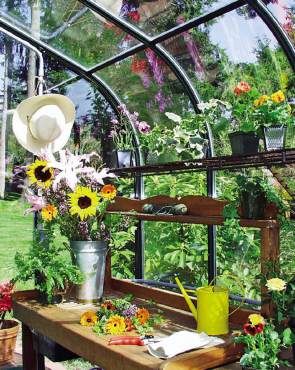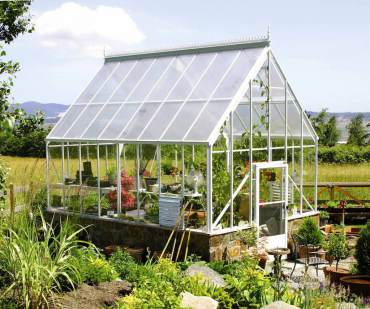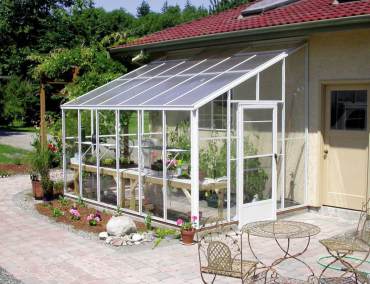 All gardeners have a wish list: new plants to try, a load of compost delivered, a potting shed, etcetera, but there is one thing that always seems to top the list — a greenhouse. Imagine how the midwinter blues melt away as you walk through the doors of this warm, humid haven for plants. It is that wonderful space where magic happens when it is cold outside.
All gardeners have a wish list: new plants to try, a load of compost delivered, a potting shed, etcetera, but there is one thing that always seems to top the list — a greenhouse. Imagine how the midwinter blues melt away as you walk through the doors of this warm, humid haven for plants. It is that wonderful space where magic happens when it is cold outside.
The lust begins when you visit a greenhouse retailer’s booth at a garden show. Your mind wanders to all the ways your gardening life would be better with a greenhouse. There are many reasons gardeners crave a greenhouse in their own backyard. Getting a head start on start tomatoes, vegetables and flower seeds; a way to grow varieties you cannot find in garden stores; save money and a means to indulge our zone denial by overwintering tender, collectable plants.
With the surging interest in growing food and getting back to the basics of gardening, greenhouse sales are increasing nationally. The United States is still no match to the greenhouse market in England, where one in five homes has a greenhouse and it is more a lifestyle than a dream.
What the popularity in gardening means is availability; there are numerous suppliers of greenhouses and it takes homework to make the right investment. A greenhouse purchase can be a “you get what you pay for” mentality but it also needs to be a “buy what you need” line of thinking. Greenhouses can be expensive based on what they are constructed from and what they are outfitted with that creates the optimum greenhouse environment. Getting to know what a greenhouse environment is like and how it can work for you is important. When you take time to decide what you need and how materials, size, and your budget will accommodate a home greenhouse, the adventure begins.
Here is a checklist of things to think about:
 Location
Location
Site a greenhouse where it gets maximum winter sun. Observe how trees and buildings block light through the day in all seasons. Natural lighting is important and in the Pacific Northwest climate, it becomes a commodity to a greenhouse.
If you have to site the greenhouse under tall trees or where it will get a snow load, choose the appropriate construction. Glass could be a danger around falling branches, and a plastic lightweight structure may not take the weight of ice and snow. Make it easy to access. You will need to get water and electricity to it. You also need to check if a permit is required to place a greenhouse on your property.
Size
Buy what you need and what your budget will allow. Most hobby greenhouse owners wish for more space. Buy the size you are willing to maintain and heat while it will also meet your needs. When shopping, imagine how many flats will fit for seed starting or where large tender plants will fit. This will help you personalize the space to your needs. The size can also be determined by the location in your garden. Is there room for what you want or do you have to make accommodations for it?
Style
Is the structure part of the main attraction in your garden that must be designed into the landscaping? Carefully look at placement and how it integrates into the space. A beautiful glass, conservatory style surrounding a cottage garden can enhance the look. An inexpensive, plastic style may be best out of sight. Simple poly or metal hoops styles are suited to utility working spaces. Knowing where and what you need will help you begin to choose the actual style of the structure.
 Needs
Needs
You need to tailor your greenhouse to what you are going to use it for: starting seeds, overwintering plants, growing tropicals or all of the above. All these things have different temperature and lighting requirements. Heating and auxiliary light in a greenhouse can be costly or efficient, based on the material the greenhouse is made out of.
Carefully consider how you are going to use it. Are you a fair- or foul-weather gardener? If you are only going to use the greenhouse for starting seeds in the spring, then you may not have to make a significant investment in a super-efficient system, just one that does a good job and can be heated and lit in the late winter to early spring. Prized orchids, tropicals to overwinter or specialty propagating will need environmental controls that will add to the investment and maintenance. Choose a greenhouse style based on your needs.
Greenhouses are typically defined and outfitted by the temperature maintained:
- A cold greenhouse (35 to 45 degrees F) is used to keep plants from freezing and to overwinter, but not necessarily encourage new growth.
- A cool greenhouse (45 to 50 degrees) will safely overwinter citrus plants. Leafy and root crops will grow well. Minimal heating is needed based on your climate zone.
- A moderate greenhouse (55 to 60 degrees) can be used to start cool crops and some propagating.
- A warm greenhouse (65 to 70 degrees) is maintained to grow tropicals and warm weather crops like tomatoes and peppers.
Materials
The makeup of the walls and roof will define the greenhouse for lifespan, energy efficiency, light transmission and ease of setup. Materials include glass, polycarbonate, polyethylene film, fiberglass and acrylic. There are many reasons to choose a specific type of material for your greenhouse. It comes down to doing a little research and knowing what you want out of your greenhouse as well as what your budget, time and space will allow. Greenhouses also need a floor, such as gravel or brick, and a foundation that is level and square so the main structure of the greenhouse can be anchored securely.
Budget
Build your own, use kits or readymade — there are many options for how to budget a greenhouse into your life. A do-it-yourself plan is less expensive but more time consuming and you need to be honest about your construction skills. If you are not familiar with wiring electricity and such, get help from a professional.
Readymade, built by the manufacturer on site, will probably be the expensive option but you know it has been done correctly and there will probably be a warranty from the manufacturer. A good in-between option is a greenhouse from a kit. They vary from cheap and good for only a few seasons to upscale construction that may take help and time to get it done right. The packaged kits may have add-on accessories like lighting and heating that help you get exactly what you need for the space and climate you want.
Maintenance
All greenhouses have ongoing maintenance; some styles need more, some less. Things to look for include the control of sun and shade; you may need to purchase shade cloth for protection from summer sun.
Venting is vital to a greenhouse environment. Most kits and readymade ones have this factor built in. If you are designing your own, make sure you know how it will be done. A greenhouse that has to be manually controlled (you opening and closing vents and doors) is a full-time job, especially in growing season.
Cleaning is another factor. One grower said the best thing you can do for your greenhouse is keep it clean, inside and out. Algae and debris build up on the outside and a good washing needs to be done yearly to keep good light transmission. The inside microclimate you create is a perfect haven for disease and problems, so cleanliness will make it a happier place for plants.
This article was first published in the Winter of 2010 print edition of the WestSound Magazine. Any discrepancies, omissions, or inclusions that seem incorrect are purely due to the age of this article. WestSound Magazine deemed this article useful and beneficial as a contribution to today's readership, and therefore is included in this site's online article archives. If you feel the content of this article is detrimental due to its age, please feel free to contact us to request removal or modification.




























